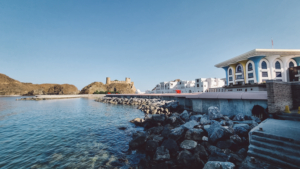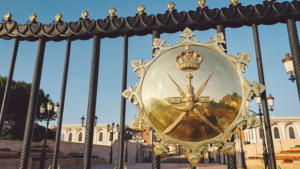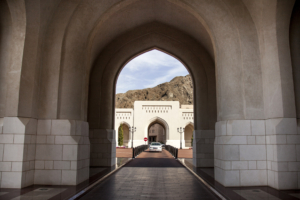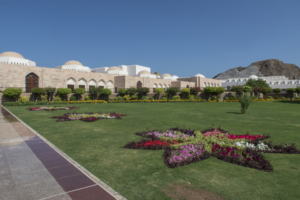

Al Alam Palace Muscat: Unveiling the Secrets of Oman’s Iconic Landmark
Al Alam Palace Muscat stands proudly between two 16th-century Portuguese forts. The palace’s striking gold and blue pillars and contemporary Islamic architecture engage visitors instantly. This ceremonial palace holds special significance as Sultan Qaboos’s most important royal residence among eight palaces in Oman.
The architectural marvel has been home to six generations of Omani rulers and remains the nation’s ceremonial heart. The palace’s name translates to “The Flag Palace,” reflecting Oman’s perfect fusion of traditional heritage with modern sophistication.
Let us explore this iconic landmark’s royal legacy, architectural magnificence, and ceremonial importance in Old Muscat. The palace’s strategic location and cultural significance have helped shape Oman’s identity while serving as a powerful symbol of national pride.
The Royal Legacy of Al Alam Palace
Taking a closer look at the rich history of Al Alam Palace Muscat reveals a fascinating story that spans over two centuries. This magnificent structure developed from its humble beginnings to become Oman’s premier ceremonial palace.
From Bait Al-Alam to Modern Marvel
The palace’s origins date back to the early 1800s, known then as Bait Al-Alam (House of the Flag). Imam Sultan bin Ahmed, the seventh direct grandfather of Sultan Qaboos, built the original structure through collaboration with Portuguese engineers. The palace stands on the foundations of an old sea wall, which highlights its strategic importance from the beginning.
Six Generations of Omani Rulers
Multiple generations of the Busaid dynasty have walked through these halls. The palace served as the residential headquarters for Omani rulers until Sultan Said bin Taimur’s era. Sultan Qaboos started a bold renovation project in 1971 that began a transformative chapter. The most important changes included:
- Complete architectural redesign with contemporary Islamic elements
- Integration of modern amenities while preserving cultural significance
- Extension of two distinctive wings from the central structure

Evolution of Royal Architecture
The palace transformed from a traditional ruling house to Oman’s premier ceremonial venue. The current structure emerged in 1972, showcasing a perfect blend of heritage and modernity. Al Alam Palace became the nation’s main venue for high-ranking diplomatic receptions, while Sultan Qaboos preferred his residences in Al Seeb or Manah for personal use.
The palace maintains its ceremonial role under the current Sultan, Haitham bin Tariq, who ascended to the throne in 2020. Distinguished guests including the Queen of England and the Queen of the Netherlands have visited the palace, which stands as a symbol of Omani diplomacy and sovereignty.
Architectural Magnificence
Al Alam Palace Muscat stands as a masterpiece of contemporary Islamic design, showcasing remarkable architectural brilliance. The palace complex immediately captures attention with its unique presence that perfectly embodies Oman’s design philosophy of ‘elegant humility.’
Fusion of Traditional and Modern Design
The palace showcases a remarkable blend of architectural styles where contemporary Islamic elements seamlessly merge with traditional Omani esthetics. A distinctive cube-like central building stands between two extending wings that create perfect balance. The design’s special quality lies in its modest yet modern elements that reflect Oman’s architectural grandeur.
Symbolic Elements in Palace Architecture
Symbolic elements speak through the palace’s design:
- Geometric patterns reflect Islamic artistry
- Highly polished marble surfaces capture sunlight
- Long pedestrian boulevard stands between arcade colonnades
- Flat, overhanging roof design adds character
The Famous Gold and Blue Columns
The palace’s signature facade features trumpet-shaped flaring columns that create its most striking feature. Royal blue and gold adorn these magnificent pillars, creating an ever-changing display as daylight dances across their surfaces. This color combination carries deep meaning – it represents Oman’s royal heritage while creating stunning contrast against the stark white walls.
Al Alam Palace’s uniqueness stems from its powerful architectural statement that complements its surroundings perfectly. The design takes a subtle yet impressive approach to royal architecture, unlike neighboring Gulf states’ towering skyscrapers. Each element serves both esthetic and symbolic purposes beautifully.

Heart of Ceremonial Traditions
The ceremonial realm of Al Alam Palace Muscat blends ancient traditions with modern diplomacy. This magnificent structure stands as more than just a palace – it represents the ceremonial core of Oman’s state functions.
Royal Protocols and State Functions
The Sultan’s presence can be determined by the flag flying atop the palace, following English royal tradition. State functions observe ceremonial protocols with great care. Visiting heads of state receive traditional 21-gun salutes. New ambassadors present their credentials formally. The grand reception hall hosts ceremonial coffee services, while official processions move through the palatial courtyard with precision.
Notable International Visits
Al Alam Palace has hosted prestigious diplomatic events over the last several years. Queen Beatrix of the Netherlands’ state visit in January 2012 showed the palace’s excellence in hosting royalty. The palace welcomed President Abdelmadjid Tebboune of Algeria recently, which highlighted its ongoing role in building international relations.
Cultural Significance in Modern Oman
Al Alam Palace represents much more than a ceremonial venue in today’s Oman – it’s a living symbol of national identity. The palace’s inner grounds remain restricted to the public, yet its presence in Old Muscat inspires pride among locals and visitors alike. The palace stands as evidence of Oman’s diplomatic excellence and cultural heritage, striking a perfect balance between traditional values and contemporary governance.
The palace retains its exclusive character while hosting events that shape diplomatic history. Each ceremony and state visit enriches its legacy, cementing its position as modern Oman’s ceremonial heart.

Strategic Location and Surroundings
The strategic setting of Al Alam Palace makes it truly remarkable as it sits in a natural harbor along the Gulf of Oman. This palace’s location weaves a captivating story of maritime heritage and architectural brilliance.
Portuguese Forts as Palace Guardians
Two mighty sentinels dominate the skyline – the Al Jalali and Al Mirani forts, constructed by Portuguese forces in the 1580s. These twin fortifications create more than just a spectacular backdrop and have protected the palace for over four centuries. Their commanding positions on rocky outcrops made them perfect guardians of Muscat’s hidden harbor, which stretches about 700 meters wide.
Historic Old Muscat District
Old Muscat’s government buildings showcase traditional Omani architectural elements that surround visitors with history:
- White facades with crenelated rooftops
- Wooden balconies that highlight local craftsmanship
- Traditional window shutters rich with stories of the past
Palace Gardens and Waterfront
The palace grounds stand as a masterpiece of landscape design. Pristine lawns create stunning contrasts against the rugged mountain backdrop. The waterfront location reveals breathtaking views of the Gulf of Oman’s azure waters. The gardens’ features include:
- Vibrant flower beds with colorful displays
- Manicured paths leading to scenic spots
- Native trees that provide natural shade
Qasr Al Alam road near the Omani French Museum offers intimate views of both the palace and its protective forts. This seamless blend of natural and built environments has earned the area its local nickname – “the bride of Muscat.” The name captures its timeless beauty and strategic importance.

Conclusion
Al Alam Palace shows Oman’s remarkable growth over time, blending royal heritage with architectural breakthroughs. This ceremonial palace transformed from its modest start as Bait Al-Alam into the country’s premier diplomatic venue. World leaders gather here now, beneath the watchful eyes of ancient Portuguese forts.
Striking gold and blue pillars and contemporary Islamic architecture highlight the palace’s distinct design philosophy. Oman knows how to adopt modern elements while preserving its traditions. This architectural gem remains the ceremonial heart of the nation and holds its importance through royal successions and changing times.
The palace means much more than its grand facades and manicured gardens suggest. It stands as a powerful symbol of Omani identity and diplomatic excellence. While its inner chambers stay private, the outer grandeur and strategic location in Old Muscat reveal glimpses of a world where history, tradition, and modern governance blend into a lasting legacy.
This isn’t just a trip… it’s the trip! Secure your spot today and Book Now!
